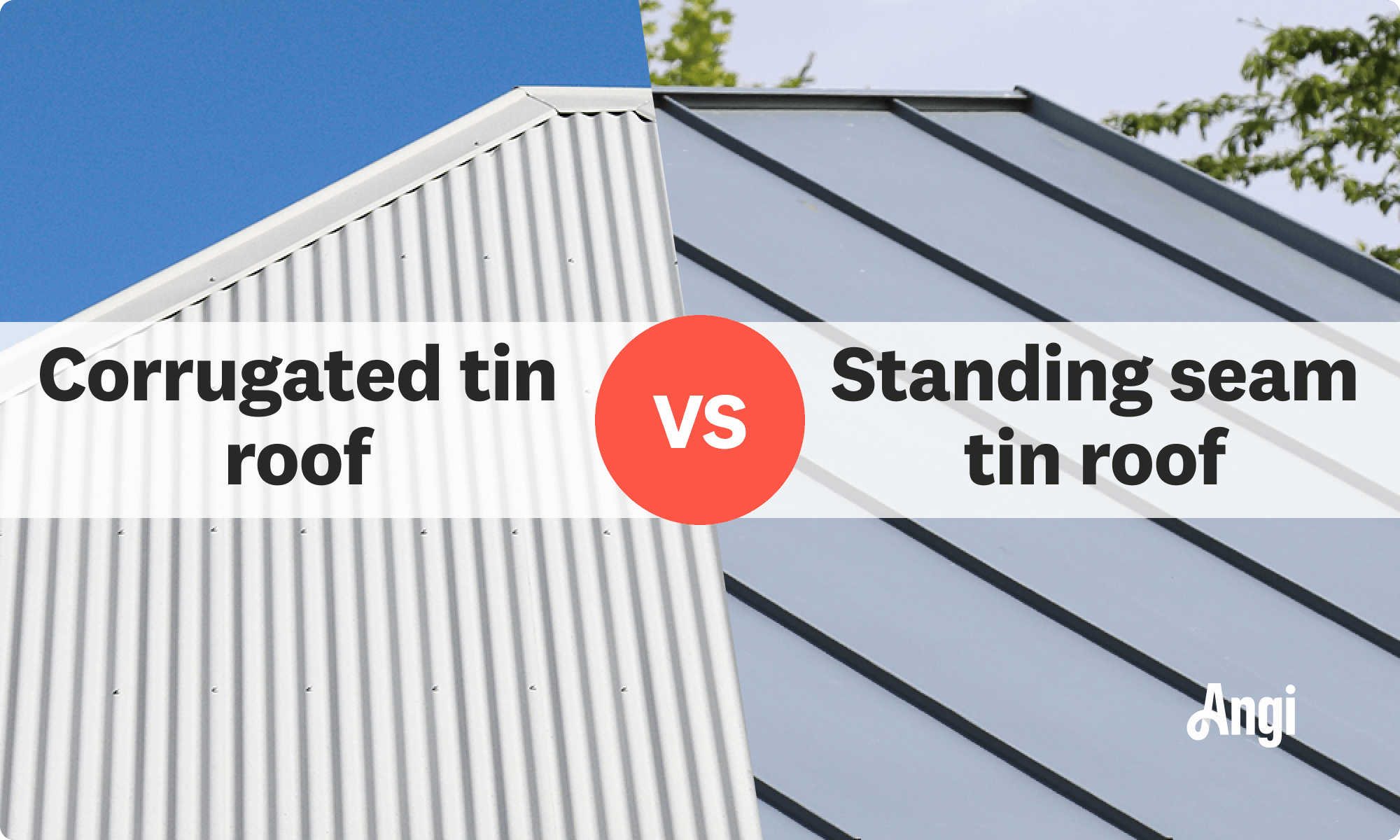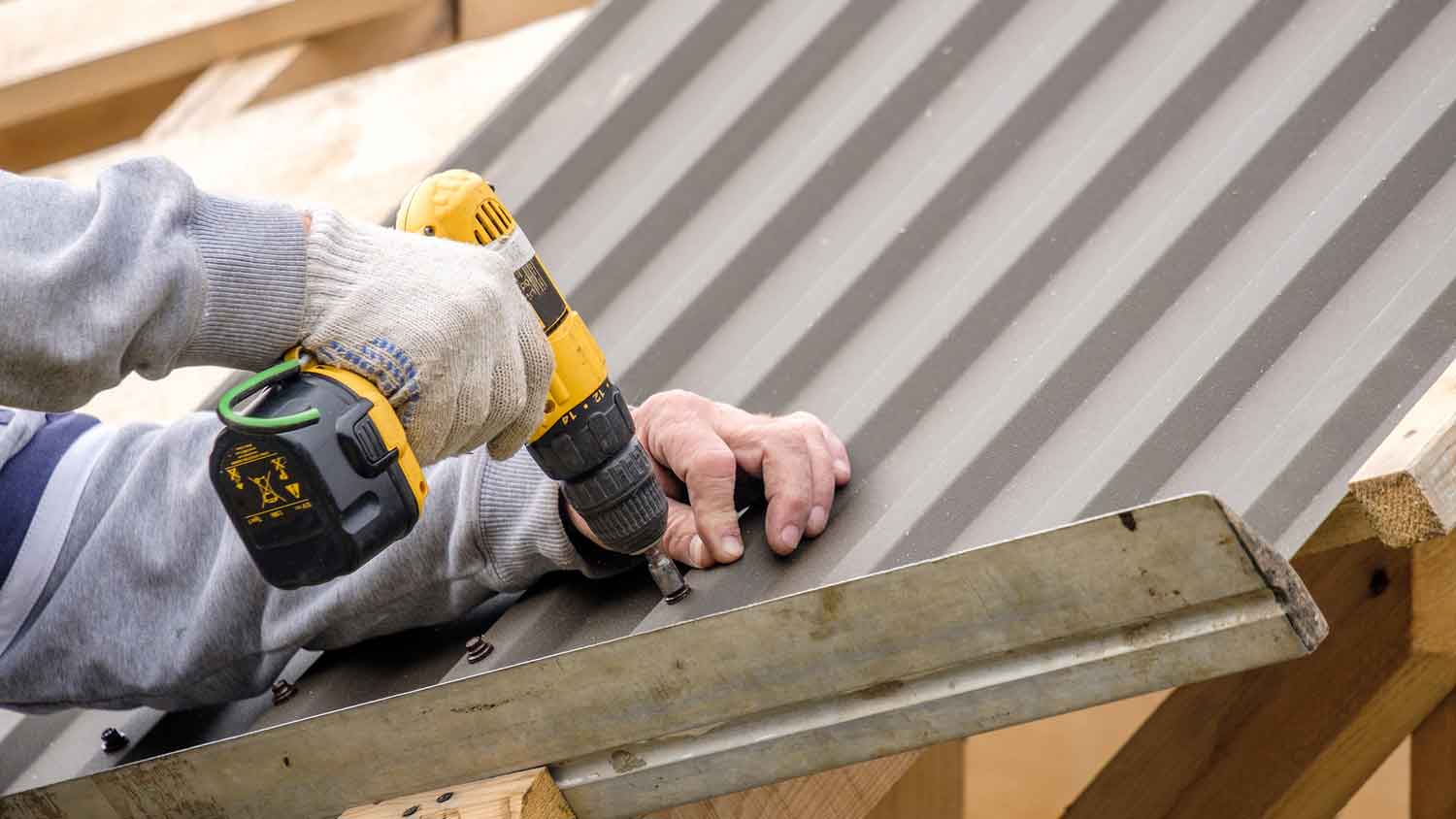How Much Does a Tin Roof Cost? [2025 Data]
Tin roof costs range from $7,500 to $18,000, with an average of $12,000. The price you'll pay depends on the roof's size and the materials you choose.


A new tin roof costs anywhere from $500 to $30,000, though most homeowners will spend $12,000. If your existing roof structure is large or requires significant repair work during the installation, you’ll pay toward the higher end of the range. The larger your roof, the higher the price will be as well, with tin roofing material coming in at between $5 and $12 per square foot.
Size of Tin Roof
Tin roof installers often charge by roof size. Metal roof measurements are normally taken in terms of roof squares, equating to 100 square feet of surface area. The size of your home or the structure on which you're installing your tin roof will determine the size of its roof. Expect to pay between $5 and $12 per square foot or between $500 and $1,200 per square.
| Roof Size (Sq. Ft.) | Average Cost Range |
|---|---|
| 200 | $1,000–$2,400 |
| 500 | $2,500–$6,000 |
| 1000 | $5,000–$12,000 |
| 1500 | $7,500–$18,000 |
| 2500 | $12,500–$30,000 |
Type of Tin Roof Panels

Considering the pros and cons of tin roofing, one of the benefits is the number of style options you have as a homeowner. The type of tin roof panel you choose will heavily influence how your home looks with its new roof. Various tin roof style types have varying price points.
| Tin Roof Type | Average cost Per Square |
|---|---|
| Corrugated | $500–$900 |
| Standing seam | $700–$1,200 |
| Powder coated | $600–$1,700 |
| Aluminum | $500–$1,200 |
Professional Roofer Costs
The cost of tin roof labor accounts for roughly half or slightly less for installation. Choosing your roofing contractor wisely can help ensure you get the best value for your money. Homeowners often also choose to incorporate adding or replacing their home's rain gutter system into the roof installation or replacement project.
Your roofing installation price will include roughly 40% to 50% of the project cost to cover contractor labor. The price covers tasks beyond just installing the roof panels.
Existing roof demolition and disposal costs: $1–$5 per sq. ft.
Installing flashing costs: $200–$500
Installing drip edge costs: $1–$3 per linear foot
General Contractor Cost
If installing your home's tin roof is part of a larger home remodeling or construction project, your general contractor will likely handle the roofing part of the project. However, you'll have the same style and material options as you would when doing the project on its own. General contractors cost between 10% and 20% of the project price to cover their overhead costs.
Additional Pros to Consider Hiring
While you're installing a new tin roof, it can be a good time to consider accomplishing some other roof-related tasks. You may want to hire an attic insulation tech or pro who specializes in chimneys, gutters, skylights, soffits, and fascia.
Attic insulation costs: $1,700–$2,100
Chimney repair costs: $160–$750
Soffit and fascia repair costs: $600–$6,000
Skylight repair costs: $1,000–$2,770
Gutter Installation costs: $625–$1,700
Additional Cost Factors
While most costs associated with the pricing for your home's new tin roof will be part of your roofing installation company's cost estimate, there are some situations that can increase the dollar amounts involved.
Demolition and Prep
Most roof demolition and disposal costs will be part of your tin roof price estimate. However, existing roofs that are very steep or difficult to access will likely cost more to remove to make way for the new materials. Expect additional demolition costs of between $1 and $4 more per square foot in these situations.
Roof Structure Repairs
If your existing roof has damage or sagging, the cost of repairing the roof structure can add between $1,500 and $7,000 to fix in severe cases.
Accessibility
Your roof's slope or pitch can affect your tin roof installation cost. Steep roofs cost more to reroof simply because it takes more time to ensure worker safety while moving around the structure. Homes with yards that create roof access issues can also experience higher roofing installation costs.
Flashing
Depending on the condition of your existing roof, some or all of its existing roof flashing will require repairing or replacing. In most situations, expect costs of between $200 and $500 for flashing replacement or repairs.
Painting
While not always necessary, choosing to add a coat of paint to your tin roof adds more weather protection and can help beautify the installation. Tin roof painting costs between $1.20 and $2.80 per square foot.
Sealing
Sealing your tin roof can help ensure it lasts as long as possible. It can also improve your roof's appearance and overall durability against harsh weather. The cost of roof sealing is between $0.65 and $5 per square foot for the additional labor and materials.
Permits
A building permit is necessary in most areas when installing or replacing a roof. Your roofing contractor is responsible for getting one and managing the subsequent inspections. However, it's good to know that the permit cost will make up between $250 and $500 of the project's price tag.
DIY Tin Roof Installation vs. Hiring a Pro
It's possible for avid DIYers to install their home's tin roof. However, doing so is extremely dangerous due to the risk of falling. Other risks include potentially being in close proximity to live electrical wires and other dangers.
Additionally, roofing installations must meet several building code requirements to make sure they can help keep your home safe and dry and will last for many years. Some metal roof manufacturers may also require professional installation or risk losing any warranty protections.
For these reasons, we suggest hiring a nearby metal roof installation company to do the job for you. Doing so will not only keep you safe but also free up several of your summer weekends for more entertaining activities.
Tin Roof Replacement vs. Repair

You may not have to replace your entire tin roof if it simply requires some repair work. Discuss the possibility with your roofing company for the best options.
| Replacement | Repair |
|---|---|
| Includes material and installation warranties | Costs less than replacement |
| Provides a new and fresh appearance | May require continued maintenance |
| Costs more than repairing an existing roof | Won't significantly change the home's appearance |
Tips to Reduce Cost While Installing a Tin Roof
The cost of installing a tin roof depends on many factors, many of which are mostly out of your control. Things like roof pitch and accessibility are unchangeable. However, there are things to consider as ways of reducing the total project cost.
Avoid special-order materials and use your roofer's existing stock.
Purchase discounted materials if available from your installer.
Discuss repair versus replacement options with your installer.
Consider lower-priced material options, such as corrugated over standing seam.
Does Installing a Tin Roof Increase Home Value?
Reports of increased home value after installing a tin roof vary widely. While every report is generally positive, the percentage of the increase differs depending on the home's original value. Smaller homes with smaller prices see a slightly higher increase, percentage-wise.
The important figure to keep in mind is the return on investment (ROI). ROIs for tin roofs range widely from around 40% to 80%. That means each dollar you spend on a tin roof could equate to between $0.40 and $0.80 of added selling price for the house, should you sell it.
A metal roof is a great choice if you live in an area with a lot of winter weather. Metal roofing stands up particularly well against heavy snowfall, hail, ice, and strong winds.
How Angi Gets Its Cost Data
Home is the most important place on earth, which is why Angi has helped more than 150 million homeowners transform their houses into homes they adore. To help homeowners with their next project, Angi provides readers with the most accurate cost data and upholds strict editorial standards. We extensively research project costs to develop the pricing data you see, so you can make the best decisions for you and your home. We rely on reputable sources, including the U.S. Bureau of Labor Statistics, academic journals, market studies, and interviews with industry experts—all to ensure our prices reflect real-world projects.
Want to help us improve our cost data? Send us a recent project quote to costquotes@angi.com. Quotes and personal information will not be shared publicly.
Frequently Asked Questions
Because metal roofs require more specialized knowledge and skills to install, they demand higher installation prices. Shingle roofs are also installable in a shorter time period, which reduces the cost of labor on a time-only basis. However, in the long term, metal roofs may actually cost less due to their extreme longevity and minimal maintenance costs.
Like any housing material, metal roofs have a unique list of pros and cons. On the cons side, metal roofs can suffer from expansion and contraction, which requires more attention to proper installation than for other roofing types. Also, the higher cost of metal roof installations is a barrier to some homeowners on a budget.
A tin roof can last between 50 and 75 years, depending on the quality of the roof and the weather conditions it is subjected to.





- Roofers
- Metal Roofing
- Roof Repair
- Roof Inspection
- Vinyl Siding Repair Contractors
- Flat Roofing Companies
- Commercial Roofing
- Emergency Roofing Companies
- Leaky Roof Repair
- Metal Roof Repair
- Business Roof Repair
- Flat Roof Repair
- Tile Roof Repair
- Slate Roofers
- Rubber Roofers
- Roofing & Siding
- Metal Roof Installation
- Affordable Roofing
- Roof Sealing
- Attic Ventilation Contractors











